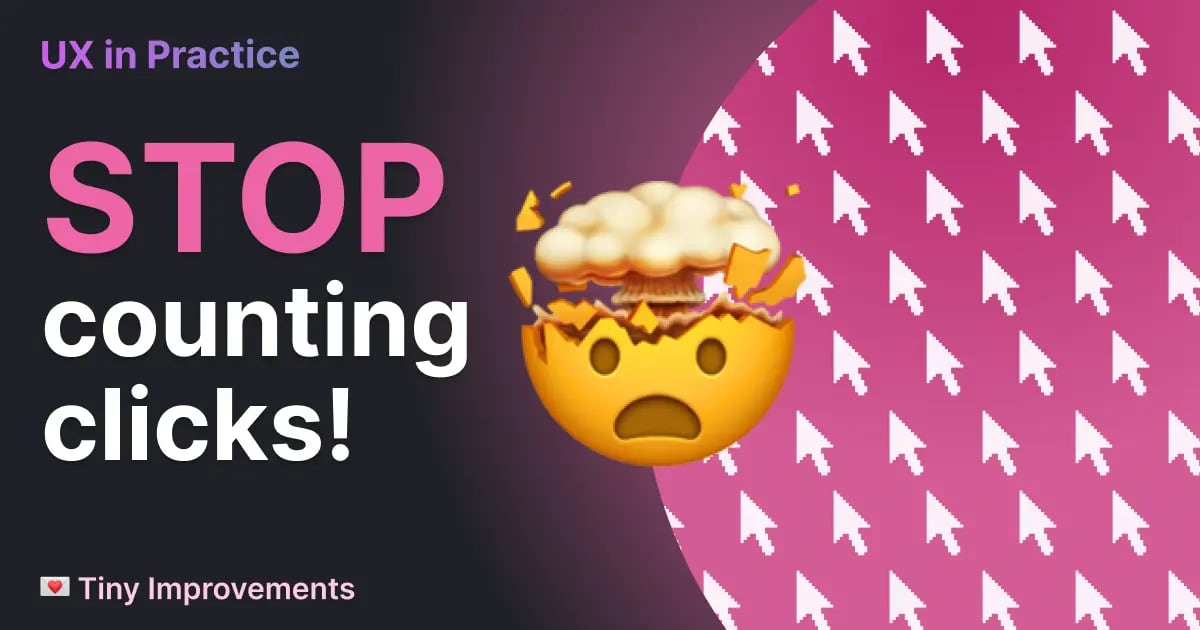
The Big Idea
"Too many clicks" isn’t the problem. It's a signal that your design isn't getting the job done. Clarity, confidence, and cognitive load are the real culprits.
Your users won't notice steps they're taking if each one is obvious and friction-free. They do notice when they’re lost, frustrated, or overwhelmed.
Listen to what they mean, not what they say
“This takes too many clicks.”
If you build software long enough, you’ll hear this from someone.
At face value, it sounds like helpful feedback. It often comes from people who aren't software designers. They may not be able to recognize and express their real frustrations with what you've built.
Thankfully, you're here to help! It's your job to respond with curiosity and empathy, and figure out what they're really trying to tell you.
"Too many clicks" is a signal that your users are feeling frustrated. It typically means something like I can't figure out how to do what I need to do.
When you hear "too many clicks" from one of your users or constituents, don't stop there - take the time to figure out what they're really trying to tell you.
Why Click-Counting Fails
You may have heard of the "3-Click Rule" - this is the idea that users should be able to find what they need to do in 3 clicks.
It's a notion that has stuck around for ages. It's simple, easy to remember, and easy to test.
But here's the thing: counting clicks sucks as a usability metric.
I'm not making this up. UX research groups far and wide have debunked this idea over and over again, including the legendary Nielsen Norman Group and Centre Centre.
Clicks are scapegoats. People only notice them when they’re frustrated.
The Real Culprit: Cognitive Load
The people using your app pay a small mental tax for everything they do while using your software.
However, not all all actions are created equally:
- Clicking is a motor load - the physical effort required to move a finger or cursor to a place and click is tiny.
- Scanning and reading what's the page is a visual load - reading isn't free, after all
- Deciding, remembering, or scanning a page to figure out what to do is a big tax. That’s cognitive load - and it's much more expensive to your users.

If you shave clicks but make people think harder, you’ve made things worse. Just as well, if you need to collet 20 fields from your users, one great big form may feel more daunting than a stepper with a handful of steps and clear indications of progress.
Better than counting clicks
Instead of obsessing over steps, measure what matters:
- Task success: Do people finish the job they set out to do?
- Time on task: Do they move through in a reasonable amount of time?
- Error/backtracks: Are they doing a lot of scrolling around or navigating to find what they need?
- Satisfaction: When all is said and done, do they feel like their work was easy?
These are meaningful measures of usability, and they get to the heart of what people are feeling while they use your apps.
What you should look for instead
When someone says “too many clicks,” dig a little deeper, and interrogate what’s really going on.
Here are some common reasons people feel like they’re clicking too much:
- The flow doesn’t match their mental model
- Labels are unclear
- Nav hierarchy is confusing
- They’re not confident in what the right next step is
Your job isn’t to delete clicks. It’s to fix the underlying friction.
So - stop counting clicks to fix your design, and instead, focus on the overall experience.
If a flow is clear, users won’t care how many taps it took. If your design is really successful, people won't notice that you did anything for them at all.

Don't take my word for it
There are plenty of reputable sources documenting why click counting should never be your goal. If you're looking for some more reading on the topic, check these out:




